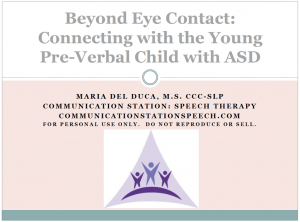I’ve been working with children on the Autism spectrum for the last 16 or so years. I’ve noticed more consistently in my state (Minnesota) that these students are not always being serviced by the Speech Language Pathologist. I’ve heard some colleagues mention that these students need services from an Autism specialist or that they need ABA services and that speech therapy can do nothing to help them. Some of this is an issue of caseload sizes-I get it. It just makes me sad when the answer to caseload sizes is to stop servicing students instead of hiring more speech language pathologists. That’s a complex issue related to funding which would I could probably write about at length-some other day perhaps. It’s probably just because I love working with this population so much that I get concerned.
Communication is the tool by which we relate as human beings. I’m a story teller by nature, but if you observe others in conversation-most of it is sharing stories or experiences. We bond over past experiences (Remember that time when you got locked in a dumpster? Wasn’t that hilarious?)
I want these clients to be able to request but also to be able to stay in a back and forth interaction. I want them to be able to tell their parents what they did at school and how they felt about it. I want them to learn how to share a memory with another person. I want them to be able to tell a joke and giggle with their friends. I want them to have at least one friend. I don’t always get there but that’s my end goal for them.
Here’s a secret of mine: I don’t really care if these clients learn how to use an embedded clause or communicate using the appropriate verb tense forms. I want to focus more on pragmatics than on form with them. Okay, I said it-please don’t take away my ASHA card.
Instead I try to work with parents to focus on building up foundational skills such as Joint Attention and turn taking. This brings me to a produce I purchased from Maria at Communication Station: Speech Therapy “Beyond Eye Contact: Connecting with the Young Pre-Verbal Child with ASD.”
- Observation of the Child: Provides specific information for what to look for as well as what objects and toys to use during your observation.
- Accommodating for Sensory Needs: This section provides basic information related to what sensory needs you should assess during your observation. Additional power points are available to provide more detailed information related to sensory processing.
- Following the Child: Learn how paying attention and valuing the child’s interests can help you connect.
- Using High Emotions: Discusses the importance of exaggerated emotions as well as some activity ideas.
- Bringing the Child Into Your World.


